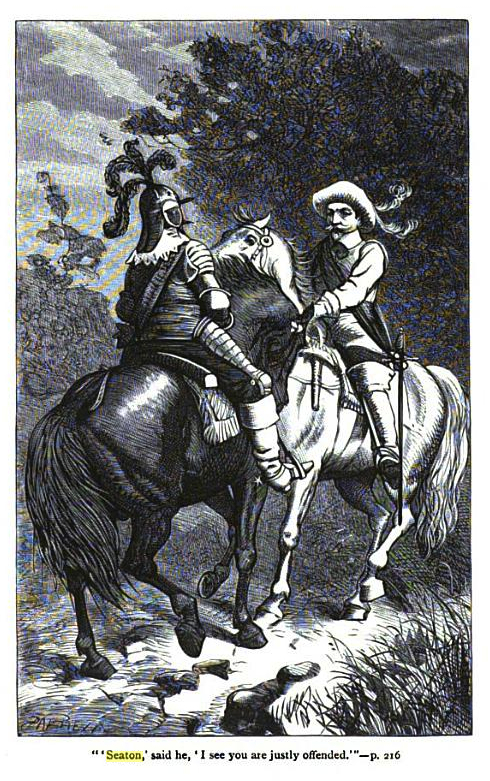|

Admiral Alexander Seton
(Seaton) ' younger of Lathrisk', Governor of
Stralsund in Sweden.
Alexander Seton was the
second son of Patrick Seton of Lathrisk, and was sent to be
raised a soldier in Holland. He assisted in the Funeral of
Chancellor Alexander Seton, 1st Earl of Dunfermline in 1622, before he
joined the Scottish contingent sent to German wars in the
Thirty Years War, and entered the service of Christian IV of
Denmark, and advanced to the rank of a Captain of infantry
on the 8th April 1626. While he is referred to as
Captain Seaton, Lieutenant Seaton and Colonel Seaton, his
nickname also noted in the Danish and Irish records refer to
him as 'Sanders' and 'Sanderson' Seaton as
well.
In the year 1612 Gustavus
Adulphus procured several companies of infantry from
Scotland, and formed them into two regiments. According to
Puffendorf, he had also sixteen Scottish ships of war, by
which he captured the town of Drontheim (or Trondeim), in
Norway, and cleared the southern shores of Sweden. His
Scottish troops served him faithfully in his Russian war,
particularly at the storming of Pleskov and Kexholm, at the
mouth of Lake Ladoga; and in 1620 he had still a stronger
body of these auxiliaries, led by Colonel Seaton and Sir
Patrick Ruthven, who won high honours at the capture of the
Livonian capital and the storming of Dunamond and Mitan, in
Courland.
Later, upon request by the
Danish king to the Scottish Privy Council, they allowed
Seaton to levy 500 Scottish soldiers on the 30th June, and
after service there as Colonel, on the 28th of February
1627, he was advanced to the rank of a Lieutenant Colonel.
In September, he was wounded in battle near Oldenburg along
with Colonel's MacKay and Forbes, while securing Bernhard of
Saxe-Weimar's rear against Johann Tserclaes, Count of
Tilly's forces during the Battle of Heiligenhafen.
Nevertheless, he recovered and joined Donald Mackay's
regiment, commanding it during the Battle of Stralsund where
he succeeded the Danish-German mercenary Heinrich Holk as
Governor of Stralsund. During the time he was in command the
town withstood the siege of Albrecht von Wallenstein's
Imperial Army, which ended on the 4th August,
unsuccessfully.
Nowhere did the Scots do
their duty more nobly than there, and medals were struck in
their honour, while Hepburn was knighted. "Here," says
Munro, "was killed the valorous Captain Macdonald, who with
his own hands killed with his sword five of his enemies
before he was killed himself. Divers also were hurt, as was
Captain Lindesay of Bainshaw, who received three dangerous
wounds; Lieutenant Pringle and divers more, their powder
being spent; to make good their retreat falls up Captain
Mackenzie with the old Scottish blades of our regiment,
keeping their faces to the enemy while their comrades were
retiring; the-service went on afresh, when Lieutenant Seaton
and his company alone, led by Lieutenant Lumsden, lost about
30 valorous soldiers, and the lieutenant seeing Colonel
Holke retiring, desired him to stay a little and see if the
Scots could stand and fight or not. The Colonel, perceiving
him to jeer, shook his head and went away. In the end
Captain Mackenzie retired slowly with his company till he
was safe within the walls; and then he made ready for his
march towards Wolgast, to find his Majestic of Denmark."
(Munro's Expedition, 1637.) In the end Wallenstein was
forced to raise the siege and begin a shameful retreat.
The regiment received colours
whereon his Majesty (Christian IV) would have the officers
to carry the Danish cross, which the officers including
Seaton refused. They were summoned to compeer before his
Majestie at Raynesburg to know the reason of their refusal.
Captain Robert Ennis was sent home to learn the wish of
James VI, " whether or no they might carrie, without
reproach, the Danish Crosse on Scottish Colours", and where
the answer was returned that they should obey the orders of
him they served.
Noted in the book by James
Grant is the one popular story of Colonel Seaton and
Gustavus Adolphus. During this time, Colonel Seaton was on
intimate terms with the great Gustavus Adolphus of Sweden,
but with whom he seriously quarreled with. On one particular
occassion, Gustavus so far forgot himself as to give a blow
to Colonel Seaton, then of the Green brigade, who quitting
his service at once set out for the frontiers of Denmark.
"The king," says Lord de Ros,
condensing this anecdote, "ashamed of the insults he had put
upon such a brave and excellent officer, soon followed on
his own on a swift horse and overtook him. 'Seaton,' said
he, 'I see you are justly offended; I am sorry for it, as I
have a great regard for you. I have followed to give you
satisfaction. I am now, as you know, out of my own kingdom -
we are equals; here are pistols and swords; avenge yourself
if you choose.' But Seaton declared he had already received
ample satisfaction; nor had the king ever a more devoted
servant, or one more ready to lay down his life for this
prince who had so generously redeemed his hasty and
inconsiderate passion." Therefore, he did not stay
with his regiment when it entered Swedish service, and
instead joined the Norwegian infantry as a Captain in 1628,
having left Mackay's troops as a Colonel.
For the next 17 years, little
of his life is known, only that he took leave for a time to
return back to Scotland to aid in the care of his aging
mother, and that he had brought correspondence from two
Italian 'Scotti' of the house and family of Scott named
Peter and Corneilius who had settled in Antwerp, and were
related to William, Earl of Angus, "acknowledging their
descent from his house, and entreating his testimonial
thereupon," with a great deal more to the same purpose,
including a long letter in old Italian from Marc Antonio
Scoto, Marquis d'Agazono, dated 1622, to the same Earl with
his family tree.
There is however, a note in
the history of the remaining records for the Plantation in
Ulster, that Alexander Seaton was at this time during his
leave in Scotland, active and engaged in the settlement
there. However, by 1645 he had returned and had been
advanced to the rank of a Colonel in the Norwegian army and
navy.
Later that year he took over
eight ships of the Danish navy to fight Sweden, and there
was promoted to the rank of Admiral: the last appointment of
a British-Scot in Christian IV's service. With these
ships, he took part in the "Norwegian response", attacking
Gothenburg (Göteborg) from the sea. His assault took
place in August, just before the Treaty of Brömsebro ended
the Danish-Swedish war in favour of Sweden, on 13/23 August
1645. The last record of him is on 19 April 1649, in
the Norwegian army,
where he was supposedly killed. | 
